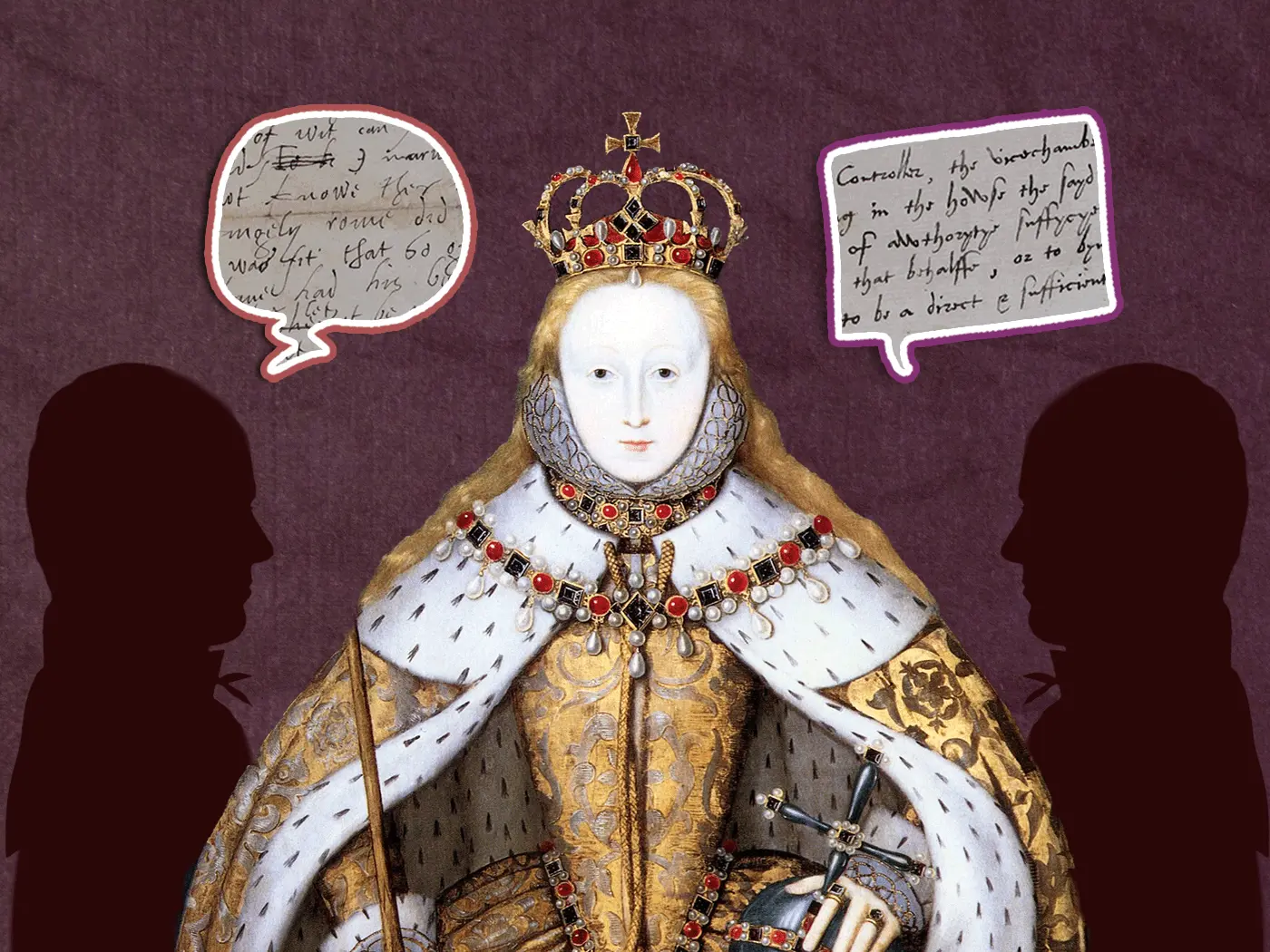Kings
The Brothers Who Asserted Their Right to Free Speech in Tudor England
Peter and Paul Wentworth called on Elizabeth I to name an heir to the throne, wielding Parliament's free speech privileges to urge the queen to take action
Amateur Historians Unearth a Long-Lost Tudor Palace Visited by Henry VIII and Elizabeth I
Locals had long shared stories of Collyweston Palace. Then, excavations in England's Midlands revealed traces of the fabled estate
Is There a Viking Ship Burial Underneath This Norwegian Farm?
Archaeologists have uncovered around 70 iron rivets that may have once held together a boat belonging to a king
The Real Story Behind 'Firebrand' and Henry VIII's Tumultuous Relationship With His Sixth Wife, Catherine Parr
A new film dramatizes how the Tudor queen narrowly avoided execution on charges of heresy
Catapult Shots Fired During 13th-Century Siege Unearthed at British Castle
Found on the grounds of Kenilworth Castle, the eight stones were used during a clash between rebels and royal forces in 1266
Ramses II's Long-Lost Sarcophagus Has Finally Been Identified
An Egyptologist recently concluded that a fragment of an overlooked granite coffin bears the great pharaoh's name
Never-Before-Seen Royal Family Portraits Go on Display at Buckingham Palace
"Royal Portraits: A Century of Photography" showcases 150 photographs taken between the 1920s and today
The British Royals' Huge Staff Once Included Exotic Cat Wranglers, Rat Killers and Toilet Attendants
A new exhibition in London offers an inside look at the lives of the workers who served the monarchy between 1660 and 1830
Charles III Unveiled His First Official Portrait as King. Is It Too Red?
Artist Jonathan Yeo's nontraditional approach to royal portraiture has drawn mixed reactions
Watch the Trailer for 'Firebrand,' a New Drama About Henry VIII's Sixth Wife, Catherine Parr
Karim Aïnouz’s film features Alicia Vikander and Jude Law as the Tudor queen and king
This Ancient Building May Have Served as a Rest Stop for an Egyptian Pharaoh's Army
Found in the northern Sinai Peninsula, the multi-room structure may have housed Thutmose III's troops over three and a half millennia ago
Ancient Maya Royals' Remains Were Burned in a Public Ceremony to Mark a New Political Regime
Archaeologists discovered charred remains of former rulers tossed "haphazardly" into a tomb in present-day Guatemala, suggesting they had been removed from their original burial sites
Archaeologists May Have Found the Villa Where the Roman Emperor Augustus Died
Excavations north of Mount Vesuvius revealed Roman ruins buried by the eruption in 79 C.E.
The Real Story Behind 'Mary & George'
The new mini-series dramatizes the Villiers family’s scandalous rise to power at the court of England's James I
Archaeologists Unearth the Long-Lost Top Half of an Enormous Ramses II Statue
A German researcher found the lower section of the Egyptian pharaoh's likeness nearly 100 years ago
The Moroccan Sultan Who Protected His Country's Jews During World War II
Mohammed V defied the collaborationist Vichy regime, saving Morocco's 250,000 Jews from deportation to Nazi death camps
Archaeologists May Have Found Traces of a Viking Marketplace in Norway
Ground-penetrating radar found evidence of a trading hub buried near the island of Klosterøy's historic monastery
What Really Happened During the Murder of Rasputin, Russia's 'Mad Monk'?
Aristocrats plotted to kill the Siberian peasant, who wielded undue influence over Nicholas II and his wife, Alexandra. But the conspiracy backfired, hastening the coming Russian Revolution
Metal Detectorist Finds Rare 1,500-Year-Old Gold Ring in Denmark
The distinctly decorated artifact may be linked to a powerful family in the area with ties to the Merovingians
Egypt Halts Controversial Plans to Renovate Ancient Pyramid
A committee of experts concluded that altering the Pyramid of Menkaure would compromise its historical value
Page 1 of 10

:focal(700x527:701x528)/https://tf-cmsv2-smithsonianmag-media.s3.amazonaws.com/filer_public/66/33/6633be10-6580-4afe-91b0-b775e7b7b000/aerial-view.jpg)
:focal(600x417:601x418)/https://tf-cmsv2-smithsonianmag-media.s3.amazonaws.com/filer_public/07/ea/07ea1ac0-c5d2-4399-8c6d-899546eeabeb/v1_ohpm_final_dn-clear1200px.jpg)
:focal(693x400:694x401)/https://tf-cmsv2-smithsonianmag-media.s3.amazonaws.com/filer_public/44/f2/44f23034-41a4-4c69-869d-a14390ab5bf9/catherine-parr2.jpg)
:focal(2548x1953:2549x1954)/https://tf-cmsv2-smithsonianmag-media.s3.amazonaws.com/filer_public/e5/8d/e58dc2bd-1734-4298-a952-29f40b0e2e91/rlh6647.jpg)
:focal(891x670:892x671)/https://tf-cmsv2-smithsonianmag-media.s3.amazonaws.com/filer_public/7d/35/7d35e898-3e4d-4d29-acbe-4a6b17bbf730/screen_shot_2024-05-30_at_95614_am.jpeg)
:focal(1525x1779:1526x1780)/https://tf-cmsv2-smithsonianmag-media.s3.amazonaws.com/filer_public/56/02/56028fe4-d987-41a1-a39c-85a8738ba7b5/2119600.jpg)
:focal(1280x768:1281x769)/https://tf-cmsv2-smithsonianmag-media.s3.amazonaws.com/filer_public/0f/c5/0fc5fc08-d21f-4dfe-842a-e483f64602e9/untold_lives_-_origins_and_identities.jpeg)
:focal(2871x1914:2872x1915)/https://tf-cmsv2-smithsonianmag-media.s3.amazonaws.com/filer_public/bf/ae/bfaeb1a3-7b06-4aae-adf9-aa51f3a6be23/gettyimages-2152372208.jpg)
:focal(700x527:701x528)/https://tf-cmsv2-smithsonianmag-media.s3.amazonaws.com/filer_public/fb/5e/fb5ef9f9-e228-4d35-b926-ff0f62a14a21/firebrand.jpg)
:focal(640x427:641x428)/https://tf-cmsv2-smithsonianmag-media.s3.amazonaws.com/filer_public/6c/97/6c97ff0a-2e8e-4bc4-8d88-31668784d3e5/440566427_818529396975275_1894332576672512603_n.jpeg)
:focal(792x663:793x664)/https://tf-cmsv2-smithsonianmag-media.s3.amazonaws.com/filer_public/36/aa/36aae55f-b260-48e8-b4ec-b845ef6d4a5f/mayan3.png)
:focal(292x220:293x221)/https://tf-cmsv2-smithsonianmag-media.s3.amazonaws.com/filer_public/85/c3/85c3bdf9-cc3a-4ac5-8305-0da04c4517ef/amphora-ceramic_1.jpeg)
:focal(1500x1000:1501x1001)/https://tf-cmsv2-smithsonianmag-media.s3.amazonaws.com/filer_public/7d/b0/7db0f5de-c832-4954-b656-53ce3abd9324/230217-mag1-103-d30-1246-trl1-a-f.jpg)
:focal(360x271:361x272)/https://tf-cmsv2-smithsonianmag-media.s3.amazonaws.com/filer_public/59/4e/594eba32-52f1-43e0-b20d-403d763b81c8/statue-ramses.jpg)
:focal(640x475:641x476)/https://tf-cmsv2-smithsonianmag-media.s3.amazonaws.com/filer_public/1b/e7/1be7c00a-6bc9-47c3-b5d2-99cfd3d37a15/mohammed.jpg)
:focal(791x595:792x596)/https://tf-cmsv2-smithsonianmag-media.s3.amazonaws.com/filer_public/7b/7b/7b7b593f-d25b-468a-b2a3-acb1d5de7f92/2322254.jpeg)
:focal(741x586:742x587)/https://tf-cmsv2-smithsonianmag-media.s3.amazonaws.com/filer/89/8f/898fc53f-e0ab-45ec-99f2-e33a2cdabd44/rasputin_photo.jpg)
:focal(2382x1906:2383x1907)/https://tf-cmsv2-smithsonianmag-media.s3.amazonaws.com/filer_public/9d/f7/9df7049b-a313-4dad-8da1-2f5fe4862e11/do_583818_n.jpg)
:focal(2667x2006:2668x2007)/https://tf-cmsv2-smithsonianmag-media.s3.amazonaws.com/filer_public/2b/86/2b8621a7-41a0-48be-a36d-815ef80118fa/gettyimages-1962561273.jpeg)